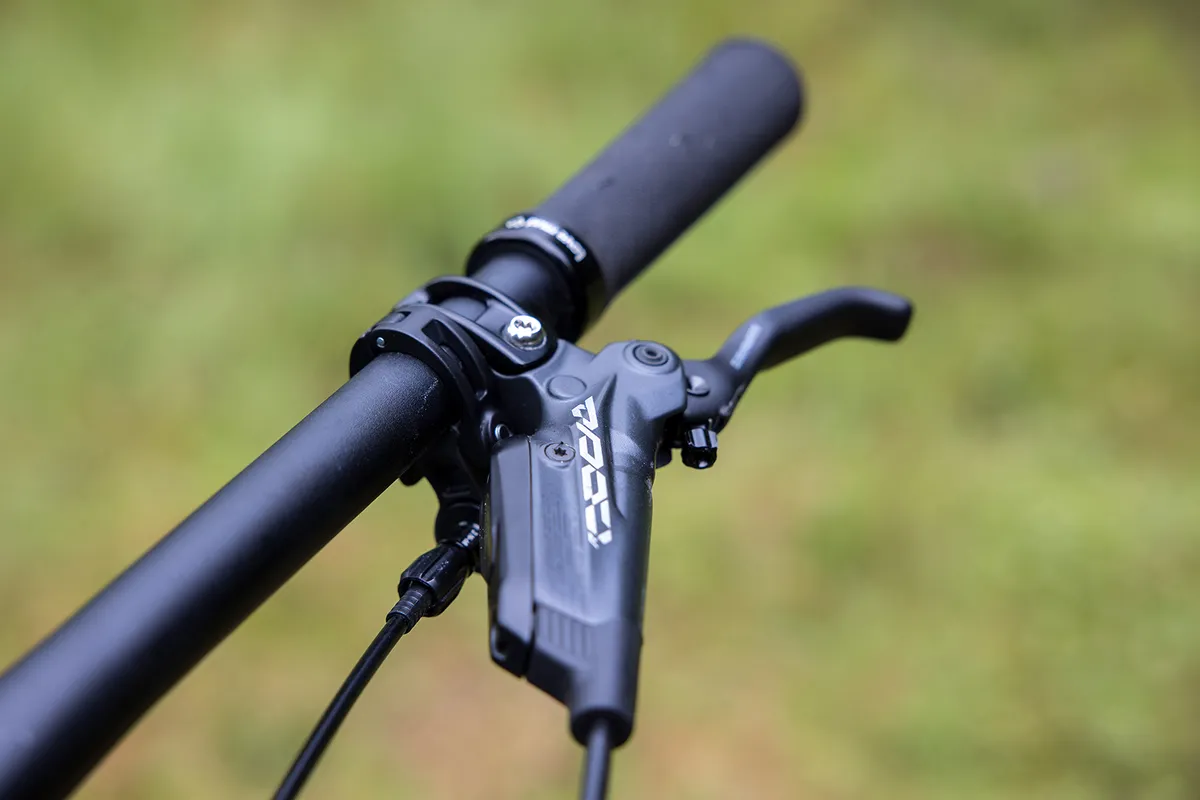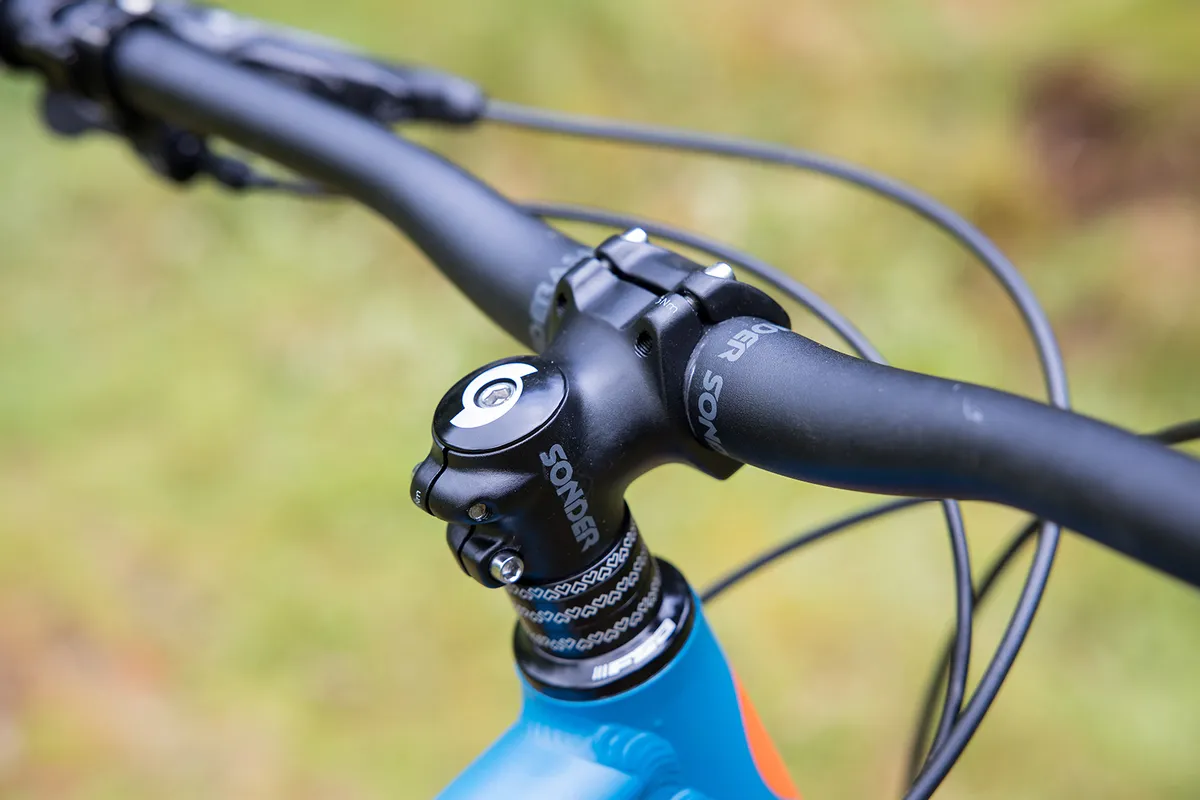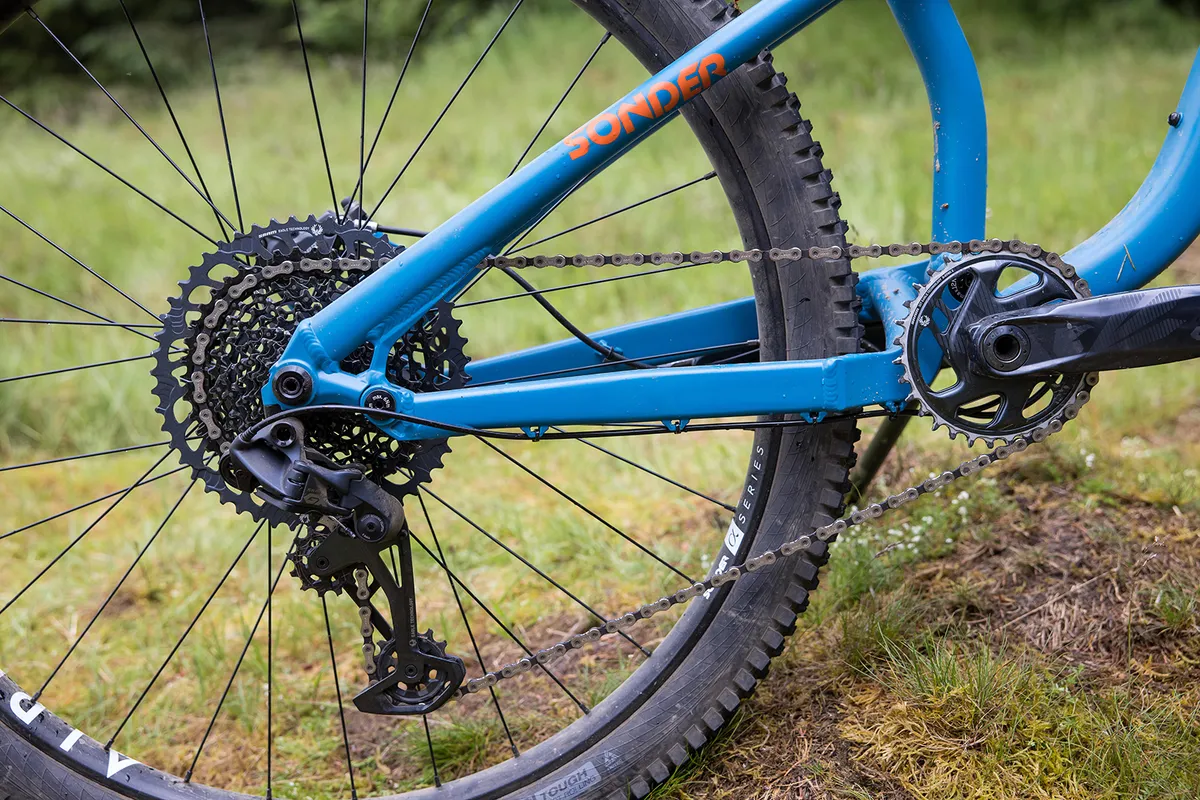Sonder’s Evol GX Eagle is designed and tested in the UK, and caters to the rather specific needs and demands of us mud-loving weekend warriors.
The brand says it's balanced the bike's performance to suit everything from trail centres to enduro with its modern long, slack and low geometry.
Sonder sells most of its bikes direct (you can also buy them from Alpkit stores), so prices are reasonable and the six builds available are all well-specced.
Sonder Evol GX Eagle details
- High-tech dampers: The Sonder’s Cane Creek fork and shock are high-tech bits of kit with loads of external adjustment. This means they can be tuned to your needs if you have the technical understanding.
- Tough rubber: WTB’s chunky 2.5in Vigilante and Trail Boss tyres help create a damped ride feel with plenty of grip and resist punctures better than skinnier counterparts.
- Posh shifting: SRAM’s GX Eagle drivetrain is commonly found on full-sus bikes costing considerably more than the Sonder; it’s great to get this level of performance at this price.
Sonder Evol GX Eagle frame, geometry and suspension details
The Evol is built from hydroformed and custom-butted 6061 alloy tubing which is said to be mix strength, weight and durability.
It’s designed around 29in wheels, with clearance for a 2.6in rear tyre. Cables are routed internally through the front triangle, and a threaded bottom bracket (BB) shell should make for easier maintenance/replacement.
The 140mm of Horst-link rear wheel travel is damped by a metric sized rear shock and Sonder says it is tuned to give a bottomless feel thanks to its progressive leverage ratio and is claimed to be active under braking.
The Evol's available in four sizes, from small to extra-large.
My large-size test sample touts a lengthy 480mm reach figure and a fairly short 445mm seat tube length that should mean riders can size up without any issues dropping the seat low enough for them.
There’s a 65-degree head-tube angle and a 75.5-degree seat-tube angle. The chainstay is 445mm long, while the wheelbase measures 1,242mm.
Combined, these figures should create a stable and competent ride on a wide variety of terrain types, and are remarkably similar to the Specialized Stumpjumper Comp Alloy, also on test, hinting both bikes are closing in on the trail bike sweet spot.
| | S | M | L | XL |
|---|---|---|---|---|
| Seat angle (degrees) | 75.5 | 75.5 | 75.5 | 75.5 |
| Head angle (degrees) | 65 | 65 | 65 | 65 |
| Chainstay (mm) | 445 | 445 | 445 | 445 |
| Seat tube (mm) | 400 | 425 | 445 | 470 |
| Top tube (mm) | 586 | 606 | 634 | 661 |
| Head tube (mm) | 95 | 95 | 105 | 110 |
| Fork offset (mm) | 42 | 42 | 42 | 42 |
| Bottom bracket drop (mm) | 30 | 30 | 30 | 30 |
| Wheelbase (mm) | 1,193 | 1,213 | 1,242 | 1,270 |
| Standover (mm) | 809 | 812 | 822 | 833 |
| Stack (mm) | 604 | 605 | 614 | 618 |
| Reach (mm) | 435 | 455 | 480 | 505 |
Sonder EVOL GX Eagle specifications
While elements of the spec can vary based on availability, this build’s titular SRAM GX Eagle drivetrain, which gives you access to a 10-52t cassette and lighter components compared to the lower NX and SX levels, won’t change – and seeing it on on a full-suspension bike at this price is remarkable.
Impressively, my bike also had boutique Cane Creek suspension front and rear – a 150mm-travel Helm MKII AIR fork (with a tokenless tuneable air-spring volume and travel adjustment without needing extra parts) and a DBair IL shock, both with external high- and low-speed compression, plus low-speed rebound damping adjustment.
You can also tweak the shock’s high-speed rebound, and it has a climb switch.
Other kit includes SRAM Code R brakes, an X-Fusion Manic dropper seatpost and plenty of own-brand parts, including Sonder Alpha 29 rims, wrapped in 2.5in WTB Vigilante and Trail Boss tyres.
How we tested
We put four do-it-all full-sus trail bikes, at the super competitive price point of £3,000, to the test on our local trails to find out which is the best you can buy right now.
Trail bikes are designed to handle everything from bridleway bashing to the odd uplift day, but categorising a trail bike by its geometry or suspension travel is becoming harder because bikes are getting lower, longer and slacker with more squish.
Generally, though, you should expect 130mm to 150mm of travel, plenty of standover room, a decent reach (the horizontal distance from bottom bracket to head tube, which affects how a bike feels when stood up on the pedals) and a stable head angle, between 64 and 66.5 degrees.
Also on test
Sonder Evol GX Eagle ride impressions

On seated climbs, the Evol’s slack-feeling seat-tube angle put my hips – and weight – further towards the rear axle than I’d have liked, and I found I had to lower my shoulders forwards to reach the bar comfortably; a position reminiscent of long top-tube XC bikes, rather than all-rounder trail bikes with modern geometry.
The Sonder didn’t feel particularly well-balanced on steep ascents, where the front wheel was prone to lift unless I nursed the bike along with frequent weight shifts towards the bar.

The constant need to nurse the bike uphill did become tiring, especially compared to the Vitus Escarpe 29 CRS and Stumpjumper.
The rear Trail Boss tyre did a commendable job of holding traction, however, despite changes in weight distribution. Decreasing rear-end sag to between 15 and 20 per cent helped reduce the problem because the bike was propped further up in its travel.
Even with the increased air pressure, the suspension still felt supple deep into its stroke, which helped to create more grip on climbs or flat sections, and there was little in the way of pedal bob.

While the lack of mid-stroke support adds comfort on the ups, it makes the Evol feel wallowy on the downs, where it exhibits a distinct lack of pop or playfulness.
When I inputted the bike’s shock, rocker and pivot locations into Linkage (a suspension kinematic calculator programme), it revealed an overall falling rate of progression that was particularly regressive in the first half of its travel. This correlated with what other testers felt on the trail, especially with the damping set to open.
To overcome this, I increased the shock’s low-speed compression damping until the bike resisted blowing through the mid part of its travel.
This worked to an extent, but it tended to make the rear-end feel numb, essentially choking the shock’s ability to quickly and proficiently absorb bumps.
Another solution could be to add volume spacers while reducing air pressure, but ultimately, I think the frame’s suspension kinematics could do with a tweak.
Although the Cane Creek rear shock helped improve the performance of the Evol, it could quite easily make it worse, especially for those with little knowledge about how to correctly adjust the damper.
On the flip side, for tech-savvy riders, the DBair IL is an impressive prospect, especially on a bike that costs this much.

The same can be said of the Helm MKII fork, which had plenty of useable adjustments on both the air spring and damping. The fork’s performance punched well above the rear suspension’s potential; its chassis was stiff, damping was well-controlled and it proved to be a highlight.
The Evol is fun to ride on tamer, slower trails but becomes a bit of a handful when the gradient gets steeper or the terrain turns chunky.

It isn’t a hard-charging ‘plough’ bike, responding better to carefully picked lines at less chaotic speeds. The geometry could have created a controlled and stable descender, so it’s a shame the rear suspension holds it back.
I found I could hammer the back-end into berms and over rocks with few repercussions, thanks to the rear tyre’s ‘Tough’ casing. And, despite the lack of inbuilt chain slap protection, the Sonder emits little to no noise on rougher trails.

Although the factory bleed on the Code brakes was poor, I know they’re serious stoppers with plenty of power and durability, plus their slightly more modulated bite makes it easier to control speed than with Shimano stoppers. If you have this problem, you’ll just need to factor in the cost of a bleed or get back in touch with Sonder to get them fixed.
The GX Eagle kit stands out, too, providing much of the performance of a top-spec groupset without the crippling price tag, and with its 52t biggest cassette sprocket, making it feel like no climb is insurmountable.

The own-brand saddle is comfy and the X-Fusion dropper reliable, with a light lever action. However, its 150mm of travel wasn’t enough given how short the seat tube is and there were times when I thought I hadn't dropped the post when I had. I’d like to see a longer travel post to avoid manual adjustment.
Sonder EVOL GX Eagle bottom line

There’s no ignoring the sheer value for money the Evol offers.
Despite its suspension and geometry quirks, it’s a solid performer on the trails, especially if you’re willing to spend the time setting it up correctly.
Product
| Brand | sonder |
| Price | 2599.00 GBP,3149.00 USD |
| Weight | 14.6000, GRAM (L) - without pedals |
Features
| Fork | Cane Creek Helm MKII AIR 29, 150mm (5.9in) travel |
| br_stem | Sonder, 45mm |
| br_chain | SRAM GX Eagle |
| br_frame | Hydroformed and custom-butted 6061 aluminium alloy, 140mm (5.5in) travel |
| Tyres | WTB Vigilante Light/High Grip 29x2.5in (f), WTB Trail Boss Tough/Fast Rolling 29x2.4in (r) |
| br_brakes | SRAM Code R, 180/180mm rotors |
| br_cranks | SRAM GX Eagle, 32t |
| br_saddle | Sonder Kura |
| br_wheels | Sonder Alpha 29 |
| br_headset | FSA Orbit |
| br_shifter | SRAM GX Eagle |
| br_cassette | SRAM GX Eagle, 10-52t |
| br_seatpost | X-Fusion Manic, 125mm |
| br_gripsTape | Sonder Clutch |
| br_handlebar | Sonder Aspect, 780mm |
| br_rearShock | Cane Creek DBair IL |
| br_bottomBracket | SRAM DUB |
| br_availableSizes | S, M, L, XL |
| br_rearDerailleur | SRAM GX Eagle (1x12 |





















